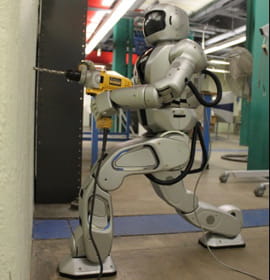DARPA robotics challenge

A 10-school collaboration led by Drexel University is one of several groups worldwide who are working to advance robotics technology for disaster relief as part of a challenge laid down by the U.S. Defense Advanced Research Projects Agency. Teams from academia, industry and the private sector will attempt to design and deploy a robot capable of disaster response in radioactive or bio-contaminated areas; the robot must drive vehicles, navigate human-centered environments, use tools and manipulate equipment.
Drexel’s partners in the challenge are Columbia University, the University of Delaware, Georgia Institute of Technology, Indiana University, Korea Advanced Institute of Science and Technology, Ohio State University, Purdue University, Swarthmore College and Worcester Polytechnic Institute.
“Accidents in nuclear and chemical plants often prohibit deploying first responders,” said Dr. Paul Oh, a professor in Drexel’s College of Engineering and the leader of the team. “DARPA pushes the envelope by challenging the robotics community to deliver a proven solution in 15-months. Such delivery will be transformative, not only for disaster mitigation and humanitarian relief efforts, but in areas like manufacturing, agriculture, construction and even elder-care.”
Researchers from each of the schools will be working in regional collaborations to tackle specific aspects of the challenge, which is broken into eight specific events related to disaster mitigation. The robot must mount, drive and dismount a vehicle; travel across rubble; remove debris; open a door, ladder climb; use a tool to break through a concrete wall, locate and shutoff a leaky valve; and remove and replace a pump.
The Drexel-led group is one of seven selected for Track A funding by DARPA and must develop their own robot and operation software.
Teams will work toward reaching goals by two target points during the 27-month competition that begins in October. Phase 1 will last 15 months and culminate with a competitive challenge that will test the robots’ ability to complete the eight events. DARPA will then select teams to continue into Phase 2, for another head-to-head competition 12-months later.
“Drexel’s partnership with the Korean Advanced Institute of Science and Technology (KAIST) plays a pivotal role in team’s strategy,” Oh said. “KAIST is a world-leader in the electro-mechanical design and fabrication of the Hubo humanoid. Drexel and its American partners are world-leaders in information technologies and artificial intelligence. The result is a team that collectively has over 200 person-years in hardware and software design of humanoids to apply to the Challenge.”
In This Article
Contact
Drexel News is produced by
University Marketing and Communications.